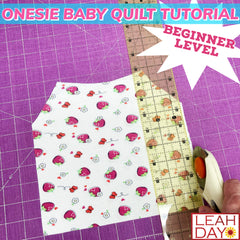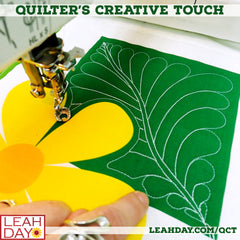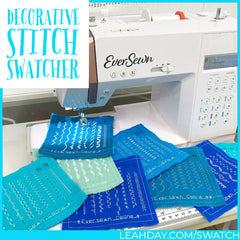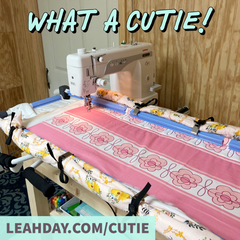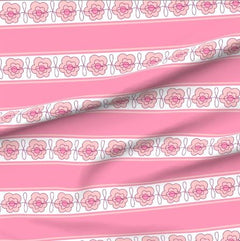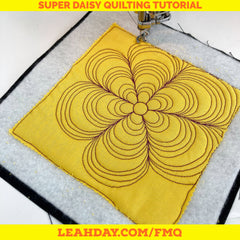Hello My Quilting Friends! Leah Day here with Episode #5 of the podcast and today I'm sharing all about teaching classes. I've taught many quilting classes over the years and while this is not really a big focus of mine anymore, I mostly just focus on teaching online, it is something I'm very passionate about.
 In short I have a lot of strong opinions about what makes a good quilting class and what makes a good quilting teacher and I think that all this information can apply whether you're teaching in person or online or anywhere in between.
In short I have a lot of strong opinions about what makes a good quilting class and what makes a good quilting teacher and I think that all this information can apply whether you're teaching in person or online or anywhere in between.
I received this request from Suzanne on Instagram and she wrote:
"How do you prepare and plan to teach a class from prep to actual class time and then post-class?"
That's the question I'm answering today!
Hello My Quilting Friends! Leah Day here and this new episode all about teaching classes. Now teaching quilting classes can happen in a lot of different ways now. You can travel and teach. That means that you travel to different quilt shops or quilt guilds and you set up and do lectures or workshops for those guilds, for those groups.
You can also teach online sites like Craftsy. I've taught for Craftsy and that can be very lucrative as well. You can also create your own classes on your own website and that's something that I'm doing a lot now where I create quilting workshops and teach different techniques in the workshop setting and then I create that and have it set up as a download. I can reach people from all over the world and teach something really cool.
I think that the question that I was being asked this whole episode came about from a woman named Suzanne on Instagram and she asked about, "How do you prepare and teach a class from preparing to actual class time to post-class?"
I really think that she was meaning an in-person class so that's going to be my focus for this episode and I'm going to really talk in-depth about it. I'm sure in the future if there's enough interest if you guys are interested in learning more about teaching online classes I can definitely do another whole podcast episode just about that.
This is going to focus in on teaching in person. I have taught in person dozens of times I think that's safe to say. I don't think I have taught 100 times in person though. It's not ever been a big focus of mine mostly because I found early on that I could teach in video and that that required me not to have to leave the house.
That became almost instantaneously my preferred method of teaching. I did travel and teach for bit from 2010 until about 2015. I did teach at a couple of big places. MQX East was probably the biggest and I had really great experiences whether it was teaching in a quilt guild setting or in a quilt shop. Every time I taught I always tried to focus in on What is my focus? What is my goal with this?
It always came down to I just want people to leave ready to quilt, ready to make this thing that we're making whether it was these quilting designs or that project and I really want them to be successful at it.
This is something that I think is really important. You need to tap into what you want to teach and also why you want to teach it. Please do take the time to do that and make sure that you really want to teach these techniques and you want to see people succeed at them.
I think this is important to explain this way because several times I've been in classes and it feels like the teacher doesn't want her students to be successful. It's so weird when this happens, it feels just to have a really, really strange example. Imagine being in third grade and your teacher is teaching you how to do multiplication tables. This is what James is learning right now, he's actually just finished up his multiplication tables.
Yet she keeps saying, "No, that's not the way you do it but I'm not going to teach you exactly how to do it," or someone asks a question and she just smiles and doesn't actually answer it. I have seen that happen in quilting classes by nationally recognized teachers who clearly don't really want you to go home and use the techniques. They don't want you to be successful.
I think that that is something that really bothers me. When I see it it really irritates me. I've taken classes from different teachers that I liked when I saw what they did online or I liked what they did, I liked their quilts or I liked their technique or whatever it was.
Then when I met them in person it was like, "Wow! This is ridiculous." Number one I did not learn anything in this class and then number two I honestly don't even want to use these techniques because I'm afraid that she is going to come after me with a copyright lawsuit. I think the first thing and most important thing is to tap into Do you actually want to teach this?
It's perfectly fine if that answer is no. If you have a technique that you've created that's very unique to you and your quilts and you don't want other people to do it and you don't really want to see it out there then that's fine. Give yourself permission not to teach that. Teach something else.
Teach a construction technique instead or teach a machine quilting design instead. If there's something that feels very precious to you then it is A-okay to save it.
But here's the one thing I have to warn you about. There is a thing called Spontaneous Invention. It's basically a term for same invention being invented by multiple people at the exact same time. When the world is ready for something to be born it will send multiple people the same inspiration.
You might have a really cool awesome technique that's really unique to you, but guess what? Someone else probably also has that glue and that fabric and that starch and that iron and that stitching ability and that foot and whatever else is required and she can probably do it too. Understand that even if you don't teach a technique that doesn't necessarily mean that you will never see it out in the world. Someone else can come up with it as well.
Now that we've gotten off my soapbox as you can see this is something that I feel very passionate about. I think it's very important for teachers to want to teach and want to share and have that be their core value for teaching. I think that's far more important that even how the class flows or even how things get off the ground. I think it's very important for you to want to share your information and you want to see people succeed.
Designing Your Class
Now let's talk about actually creating a class, a quilting class from the ground up. The first thing it just has to start with a concept. What do you want to teach in class?
That could be a very simple quilt, a technique. A technique usually if it's like let's say here's a construction technique that I've been playing with for a little while and that's stained glass appliqué.
Stained glass appliqué is a technique where I could design a quilt and do a class where students come and we sit and we make that quilt together using that stained glass technique. Then everyone understood both the technique and the quilt and made the quilt at the same time. That would be a cool way of merging the two together.
You could also do a class where there is not a project but there is a technique. Something like, "Okay well I'm just going to teach you how to do the stained glass appliqué and maybe we'll just randomly cut out some shapes and randomly put them together.
Then if you want to call that quilt at the end you can or you could just throw it in the trash or you could save it as a sample. It's totally up to you but do not have that attachment to that specific wall hanging quilt or that specific design.
Now that can be a little tricky because obviously in order to get people to sign up for your class and to come you're going to have to have samples and something to show for the class. That would need to be very clear in how you market the class and what you title it. That kind of thing.
Like Learn Stained Glass Appliqué would obviously to me say a very obvious technique class. If it is Make a Stained Glass Appliqué Wall Hanging then that would tell me I'm going to go in there and I'm going to make that stained glass appliqué wall hanging quilt. That specific one.
The third type of class is a machine quilting class and that's different from both teaching an actual quilt and teaching a technique. It's technique on steroids. That is you're teaching machine quilting whether it's Walking Foot quilting or Free Motion quilting or longarm quilting. It's very specific and it does not require any fabric cutting, it doesn't require irons, it's very simple in its nature of we just need something to quilt.
Now, it could be very tempting to think, "Okay, well lets have everyone bring in quilts and we quilt together." That might work if you're in a big expo type setting or a big show type setting where that could actually be possible.
Most of the time when I've been teaching quilt shops there's just no room to do that kind of thing. What I've done always with teaching machine quilting is to have people bring in cut squares, usually 10 inch squares and then we mark a square inside of it. Usually an eight inch square inside and then quilt that square.
Now, does quilting that square really apply to your whole quilt? Yes and no and that comes in, you have to then be very careful in your instruction of saying, "Okay well we've learned something on a small scale or we've learned it in this small space. How do we expand it?" To spend part of your class time explaining that and sharing samples.
Make Many Samples for Your Classes
That is definitely something I think that's important no matter what type of style of quilting class that you want to teach is samples. Make three to four versions of the quilt that you're going to teach or if it's machine quilting then have the design stitched out. If it's a technique then make sure that you have several different quilts showcasing that technique so it's really, really clear how many different ways it can be used.
This does more than one thing. Having samples and having multiple versions of something it is eye candy for the students, it lets them see how to use the technique and it gives you much more skill in doing that technique. It gives you a lot more experience and knowledge as far as the pitfalls.
What can happen and how can this go wrong? Those are two really important things that you need to be able to answer before you teach the class.
That is another thing just make sure that when you're teaching a class that you're ready to reach it. You're ready to share it and that you've gotten enough experience with that topic or that quilt to be able to share and to answer those questions and to deal with those problems.
A good chunk of my machine quilting classes have to do with darning feet. Making sure that the darning foot works properly, getting the settings correct on a machine, sorting out stitch issues whether it's skip stitches, breaking thread, getting the right needle in the machine. All of that stuff can be quite overwhelming if that's still a struggle for you to deal with yourself.
If you've already worked past that and you feel pretty confident that you know the answers to those questions or you know how to troubleshoot them then you're ready to teach that absolutely.
If something happens to your machine and you're like, "I have no idea what's going on!" then that might not yet be a technique that you want to share. Simply because when that happens to a student and it most certainly will they will want you to answer it for them, they will want you to fix it for them. If you can't there's going to be someone that's upset with you. That's never fun either for the student or for the teacher. It's never fun for anybody.
Samples are key and I think the more samples the better. When I've gone to shows, to different classes and stuff when it's a big quilt I've seen teachers teaching huge piecing classes with huge quilts and stuff. Usually they only have one or two versions of the quilt with them from what I've seen.
When it's a smaller quilt like a baby or wall hanging usually there's multiple versions of the quilt. You can see lots of different fabric combinations, you can see that technique illustrated many different ways.
I think that's really interesting because fabric has the ability to attract or repel us. So that I might look at a wall hanging and it's all done in gray and brown and blue and it is ugly in my opinion. I see that exact same wall hanging in bright orange, red and purple and I'm like, "Give me some more of that guys." I would love it!
You've got to also keep in mind that your samples are big time marketing for your class and having a wide variety of colors and patterns is a really good idea. Also it illustrates, if it's a piecing class it illustrates what you can do depending on the fabric. There are some quilts that if you cut it out with a border print it would look completely different if you cut it out from a solid.
There's lots of variation there and lots of ways that you can be creative and as you're being creative, you're also learning and experimenting and figuring out the pitfalls, the problems, the issues that could arise as you teach.
I should say also as you're creating those samples you're also learning how to streamline it. It might be that when you start a technique out it's 17 steps from the beginning to the nice finished edge but as you do it over and over and over again you start realizing, "Well I can skip step 10. I don't need to do that extra basting, or if we use this kind of glue instead of that kind of glue then it'll hold better and I won't need to do that step." It'll streamline it.
You'll be able to cut things out and simplify it and just narrow down to what needs to be taught in a very logical, very streamlined way.
I would also advise keeping the sample small so that way they could be passed around. When you pass them around please make it clear that photography is absolutely allowed and that people can shoot photos and they can analyze your stitching and look real close at it. The whole nine yards of that. Don't be afraid of that. That's what you're there for.
You're a vessel to share the information and by passing it around people can spend more time with it, they can hold on. If it's a pot holder size they can hold it, they can squish it, they can see how those stitches look real close, they can flip it over on the back. This is what quilters like to do.
I have never seen a student look at my quilts and not flip them over to look at them on the back. It is judgment, to judge what the stitches look like. Do they look as good on the back as they do on the front? I see it and I smile because I do it myself. It's just what we do! Having them small at least a handful of samples that you can pass around is really nice and that stops the hauling everybody out of their seat thing.
This is just my own pet peeve and I'm sorry I'm including a whole lot of my opinion in this post but I have some really strong opinions when it comes to quilting classes. Whenever I demo and I only demo twice during a class. It always changes the energy of the class because everyone has to get up out of their seats and they all cluster around.
Well I noticed over time that stretching out that standing up and staring time to longer than five minutes is uncomfortable for most students. They really don't want ... Even as a student myself I know I don't want to be standing up breathing down the neck of the quilting teacher.
I would rather stay in my seat and hold and look at something or photograph something from the comfort of my seat and my machine. That's another reason why I think small samples are really helpful and I limit demoing time to really two times during class and for five minutes.
I do it right at lunch time where everybody is already getting up and shifting around so you're like, "Hey let me just show you those, those designs that we've gone over this morning." I'll stitch those out, everybody goes to lunch and then I might do a little bit of stitching after launch and then towards the end of the class everyone is packing up I'll demo then.
That way people are already in that standing up moving around the class activity. They're not as disrupted as they would be if they had taken the time to get their machines set up, they're all comfortable. If it's a really packed class it can be a pain to squeeze through people in order to get up and come and watch.
Even then if it's a lot of people in class it can be hard to see around so many heads all around the machine when the teacher is demoing. I think for all those reasons lots of samples and keep your samples small so they can be passed around and be comfortable with photography of all sizes.
I'm even comfortable of people shooting video of me but that's just me. I completely understand if you're not comfortable with video necessarily but at the same time how can it hurt? You're there to teach the student. You want them to be successful at it. They might not necessarily put that video up online but if they go home they can reference it and they can see your techniques again and they'll be more apt to be able to do it.
Do you want quilters to remember you? Make a Handout!
Now to pull all that together, a handout. Some kind of paper document that will solidify all of the information and give you a place where the student can not only get back in touch with you but also remember what they've learned.
I think a handout is pretty crucial to any quilting class. Make sure that whenever you format your handout you add headers and footers to the page so that you can include your name and your website in the header and footer of each page. Front and back.
Now this does a couple of different things, it not only reminds people where they can find you but it also stops any copyright infringement. I have heard from quilters that are like, "Well so and so copied my handout and is teaching my class and ripping me off and all this other stuff."
I've heard this before and my solution is well did you not put a copyright notice on your handout or did you not put your name on your handout that you designed yourself and you wrote?That kind of thing. You can fix that if that's a problem for you of if that's something that would bother you then you could fix it that way.
I think it's just generally a good idea to put your name on the handout so that way people remember who you are and can come back and find you and find more information about you. Whenever you're designing that document you want to start with your materials list. A little overview of the class, what people are going to learn, materials list as far as what they're going to need. If it's a quilt pattern obviously they're going to need that quilt pattern in order to make it successfully.
If you end up having space a lot of times I will see a pattern printed on one side of the paper and then the whole back being left open and blank. Use that back side too. That can be an advertisement for your store, that could be an advertisement for your book.
You could put in a little blurb about the products that you sell or the different things that you do or your next class, it's going to be nearby in a local town. Whatever it is use the space available to you and use it up. If it's going to be a handout printed front and back make sure every single inch of that space is used up so that way it feels very dense and very heavy and people will value it.
I think that's the most important thing. I was struggling with this for a while. I was printing out ... It was a four-page handout, stapled. It was a lot of work especially for a class 20 students. It's a lot of paper and that's a lot of time to print that out and staple them all together and all that kind of stuff.
I had a few students that left theirs behind and it was really bugging me. I looked at the handout and I realized there wasn't enough value in it. I wasn't giving them enough information or it wasn't valuable enough for them to take it and take it home with them and save it.
My solution to that and I think that this is a really good entry point into writing books, was I took that handout and turned it into a book and that became one of my first books Free Motion Quilting from Daisy to Paisley.
Then I did it again when I wanted to update my class and change up the designs then it became a class I would teach with Free Motion Quilting From Feathers to Flames.
Both of those books were basically handouts turned into books with much more designs added and no one is going to throw a book away. Then it not only added value to the class and that the students would continue learning after the class it also added value in the sense that I could charge the additional fee for the book. That helped the class be more profitable for me. This is something that I think is really important.
Make Sure Your Classes are Profitable, but not Excessive
When you're teaching you've got to calculate in obviously your time away, how much time you're going to be away from home, how long it's going to take you to get to the class. How long a drive or if you have to fly or any of that kind of stuff and then the effort involved making those samples, the technique. All that stuff goes into that as well.
Look at it, that is a very good way of making money. Yes, at the same time I also would say with that caveat you don't want to skin the sheep.
You don't want to have so many things priced so high and so ridiculously that people feel like they're getting ripped off. Keep your class fee reasonable or if you're working with quilt shop make sure that they are comfortable with your class fee and everything is good there.
Then if you are offering a book or something offering some sort of discount for the shop, where the shop is basically wholesaling them from you or buying them from a distributor then the shop is obviously making money too.
If it's a guild setting obviously there's no shop involved, there's no squishiness there involved with that. You can just offer the book. Say, "If you have a book that's great just bring it but if you don't have a book yet then here I'll have them available for sale." That does make the class more profitable. That allows you to then make more classes and then to make more quilts and make more patterns and to keep your business running.
It all goes into itself and is all helpful and I think that's turning a handout into a book. It worked out really successfully for me and both of those were small books. They were like 100 pages and they were mini books, they're 5 by 8? Yeah. 5.5 by 8.5 inches.
They're small books and so they were very easy to keep right next to the sowing machine too. I did self-publish those and that was one of those things that I know that if I had approached a big publisher they would have been like, "Well why do we want a mini size or this seems weird." I didn't even want to have that conversation. I knew what I wanted and I wanted to produce that book and that's why I self-published it. That in turn made it that much more successful.
I think all of those things are really important, making sure that you have a class that's ready to go, that you're ready to teach those techniques, you want to share them. Make some samples, create a handout, that's all the upfront work of a class.
Test Your Teaching Skills with Friends
Now the next thing is testing it and making sure that you're ready to teach it because it's one thing you've done all this work but some of it might be in your head. You know what I mean? Where you've tried out a technique and you're really good at it but you might be assuming someone is already understanding and accepting several steps of that technique.
Just an example for me is the whole extra steps, the pre-washing, starching and pressing fabric. I made the mistake for many years of assuming that everyone would do this and that was not cool.
You can't assume that someone is going to know that that's how you prepare things. It became then a very big deal to emphasize that step, to emphasize the absolute basics like I think you should pre-wash your fabric. That is my opinion but I am your teacher therefore I think you should pre-wash this fabric.
Yes I do think starch is perfectly fine to use on the fabric and it gets it stiff and it makes it easy to control and more accurate to cut. All of that is in my ... It sets the foundation for how I'm teaching. If I assume someone knows that and they don't then they could be starting off with a really bad foundation to their class and have a really unsuccessful class because of that or a really unsuccessful experience.
Testing your class will really help you with that and you can do this in a lot of different ways. It could be as simple as if you have a willing spouse or friend to come over and then you could run through the class with them and really practice the introduction. Really practice how you greet your students and how you start out the class like what kind of beat and what kind of emotion you're wanting to set off from the very beginning.
I always try and start with a good dose of energy and I'm always like, "Hello. Leah Day here." The same way I start my videos. I try and start my classes the same way. I usually also start with a lot of instructions written on the board like, "I know you're getting ready and getting everything set up and it's a lot of work but whenever you get the chance here's what you can do with your machine."
I always start off letting people know how they can get started and get established. That really sets up the students that show up early to set up. That really gets them started on the right foot and usually those students are the ones that feel most comfortable and confident by the end of class.
You're always going to have those students that are showing up right on time, exactly when the class started. Of course then they're usually a little bit behind throughout the class because they didn't have that time to set up and really get comfortable before class started. It's always nice to put that information like, "Hey you can show up 30 minutes ahead of time."
It's good to put that in your materials list if you can. Some places don't allow you to do that, like quilt guilds and stuff sometimes you have to show up right at 9 and no one gets any extra time and that's okay. I think the beginning, the intro to class introducing yourself, letting people know who you are, what you're going to learn, what your expectations for the class are. I think that's a really important time. I think that's a really important place to practice and make sure that they're setting off on the right foot.
If you don't have a friend another idea would be to host a really small class, do a little ad in your quilt guild and say, "Hey I'd love to have four to five members come for a class. It'll be free at my house or maybe we could rent time at the church or at the guild meeting house or wherever and get together." That'd be free for those members and they could be your guinea pigs. That's another way that you could test a class out and just see if it works and if it flows well.
What you're looking for there is you're wanting to get experience at the teaching. Not just the technique but at the teaching. Look out for stale spots that's where maybe half the students have reached where you are and they're waiting for the next step but then you want everyone else to catch up too and it gets stale.
Like do you go on ahead and jump ahead and then have to teach twice? That can be really tricky having students at different places in class. I've seen that myself where everyone was at a different stage in the project and depended upon the teacher to help them to the next stage. It was a nightmare for the poor teacher because she had to go around to every single student individually to give that extra instruction. Watch out for that.
Try and figure out way of keeping all the students in the ring in the right range or in the same place. Or if like in a situation you have irons being used usually there's only three or four irons across a huge amount of people. Figure out ways of splitting up that class so that there's not just a huge big line in front of the iron and lots of standing around and waiting that's never much fun.
Of course it's not always possible to get around it. You can just be aware that it's going to happen and so then maybe if that's going to happen in your class and you can't do anything about it prepare some stories, some funny anecdotes to tell during those times so it just keeps it flowing. It keeps that energy up, makes people laugh.
I'll do a lot of cheap stuff to get a laugh. I really want my classes to be entertaining and that's gotten me trouble a little bit because sometimes I'll swear in a class where I won't ever swear in a video. I'll swear in a class just to get a cheap laugh just to keep that emotion and that energy flowing. Make sure everybody is still awake.
It doesn't always work out well. I think I've gotten myself in trouble with it a few times but at the same time at the end of class you can tell when a student is happy and satisfied and has had a great experience and when she's been nodding off. I've also seen students nod off in my classes too and I think that happens as well. You can't be perfect for everybody but you can always try your best.
One last thing to test as you're teaching your class,. Let's say it's a six hour class and you've got a whole quilt to create it would be good to know if it's reasonable to expect your students to have the entire quilt done or if they will have to take it home to finish it.
If it's a small wall hanging and it's a simple enough technique they might be able to finish it in class, right? Even if it's a bed quilt and it's a simple enough piecing technique they might be able to get it finished in class.
You won't actually know until you work through it with some real people and figure out those trouble spots. If something is going to hang people up, if the line at the irons is going to be so ridiculous that half the class flags behind the other half the class it's just good to know all those types of things and just be aware of them.


